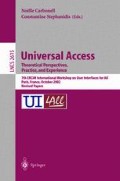Abstract
Traditional ways to handle user input in software are uncomfortable when an application wishes to use novel input devices. This is especially the case in gesture based user interfaces. In this paper we describe these problems and as a solution we present an architecture and an implementation of a user input toolkit. We show that the higher level processing of user input such as gesture recognition requires a whole newkind of paradigm. The system we designed and implemented — FLexible User Input Design (FLUID) — is a lightweight library that can be used in different kinds of software. The potential application areas include all system where novel input devices are in use: virtual reality, entertainment systems and embedded systems.
Access this chapter
Tax calculation will be finalised at checkout
Purchases are for personal use only
Preview
Unable to display preview. Download preview PDF.
References
Ilmonen, T., Jalkanen, J.: Accelerometer-based motion tracking for orchestra conductor following. In: Proceedings of the 6th Eurographics Workshop on Virtual Environments. (2000)
Ilmonen, T., Takala, T.: Conductor following with artificial neural networks. In: Proceedings of the International Computer Music Conference. (1999) 367–370 URL: http://www.tml.hut.fi/Research/DIVA/old/publications/1999/ilmonen icmc99.ps.gz.
Cohen, P. R., McGee, D. R., Oviatt, S. L., Wu, L., Clow, J., King, R., Julier, S., Rosenblum, L.: Multimodal interactions for 2d and 3d environments. IEEE Computer Graphics and Applications (1999) 10–13
Schoemaker, L., Nijtmans, J., Camurri, A., Lavagetto, F., Morasso, P., ıt, C. B., Guiard-Marigny, T., Goff, B. L., Robert-Ribes, J., Adjoudani, A., Deféé, I., Münch, S., Hartung, K., Blauert, J.: A taxonomy of multimodal interaction in the human information processing system. Technical report, ESPRIT BRA, No. 8579 (1995)
Proakis, J. G., Manolakis, D. G.: Digital Signal Processing. Macmillan Publishing Company, NewYork (1992)
Laurence, N., Joëlle, C.: A design space for multimodal systems: Concurrent processing and data fusion. In: The proceedings of InterCHI’ 93, joint conference of ACM SIG-CHI and INTERACT. (1993) 172–178
Salber, D., Dey, A. K., Abowd, G. D.: The context toolkit: Aiding the development of contextenabled applications. In: Proceeding of the CHI 99 Conference on Human factors in Computing Systems, Pittsburgh, Pennsylvania, United States, ACM Press New York, NY, USA (1999) 434–441
Mankoff, J., Hudson, S. E., Abowd, G. D.: Providing integrated toolkit-level support for ambiguity in recognition-based interfaces. In: Proceedings of the CHI 2000 conference on Human factors in computing systems, The Hague, The Netherlands,ACMPress NewYork, NY, USA (2000) 368–375
Landay, J., Myers, B.: Sketching interfaces: Toward more human interface design. Computer 34 (2001) 56–64
Bierbaum, A., Just, C., Hartling, P., Meinert, K., Baker, A., Cruz-Neira, C.: Vr juggler: A virtual platform for virtual reality application development. In: The Proceedings of IEEEVR Conference 2001. (2001)
CAVELib: Cavelib user’s manual. WWW-page (Cited 24.6.2001) http://www.vrco.com/CAVE USER/.
Reitmayr, G., Schmalstieg, D.: An open sotfware architecture for virtual reality interaction. In: Proceedings of the ACM symposium on Virtual reality software and technology, ACM Press NewYork, NY, USA (2001) 47–54
Taylor, R. M., Hudson, T. C., Seeger, A., Weber, H., Juliano, J., Helser, A.T.: Vrpn: a deviceindependent, network-transparent vr peripheral system. In: Proceedings of the ACM symposium on Virtual reality software and technology, ACM Press New York, NY, USA (2001) 55–61
Bimber, O., Encarnação, L. M., Stork, A.: A multi-layered architecture for sketch-based interaction within virtual environments. Computers & Graphics 24 (2000) 851–867
Gamma, E., Helm, R., Johnson, R., Vlissides, J.: Design Patterns: elements of reusable software. AddisonWesley Longman Inc. (1994)
Ilmonen, T.: Tracking conductor of an orchestra using artificial neural networks. Master’s thesis, Helsinki University of Technology, Telecommunications Software and Multimedia Laboratory (1999)
IBM: Ibm voice systems. WWW-page (Cited 24.6.2002) http://www-3.ibm.com/software/speech/.
Ilmonen, T.: Immersive 3d user interface for computer animation control. In: The Proceedings of the International Conference on Computer Vision and Graphics 2002, Zakopane, Poland (2002(to be published))
Ilmonen, T.: Mustajuuri — an application and toolkit for interactive audio processing. In: Proceedings of the 7th International Conference on Auditory Displays. (2001) 284–285
Author information
Authors and Affiliations
Editor information
Editors and Affiliations
Rights and permissions
Copyright information
© 2003 Springer-Verlag Berlin Heidelberg
About this paper
Cite this paper
Ilmonen, T., Kontkanen, J. (2003). Software Architecture for Multimodal User Input - FLUID. In: Carbonell, N., Stephanidis, C. (eds) Universal Access Theoretical Perspectives, Practice, and Experience. UI4ALL 2002. Lecture Notes in Computer Science, vol 2615. Springer, Berlin, Heidelberg. https://doi.org/10.1007/3-540-36572-9_25
Download citation
DOI: https://doi.org/10.1007/3-540-36572-9_25
Published:
Publisher Name: Springer, Berlin, Heidelberg
Print ISBN: 978-3-540-00855-2
Online ISBN: 978-3-540-36572-3
eBook Packages: Springer Book Archive

